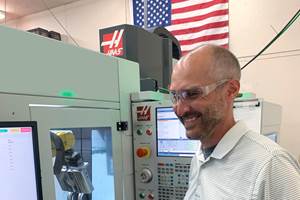Minnesota Manufacturer Integrates Software For A Mini-MES
Buying specific, flexible software products, each geared to one particular need, and integrating them, provided this shop with its own 'mini manufacturing execution system.'
Buying specific, flexible software products, each geared to one particular need, and integrating them, provided Quality Machine, Inc., of Brooklyn Park, Minnesota, with its own "mini manufacturing execution system" (MES). Integrating several software packages from different manufacturers created an ideal setup, from the time a job has entered the shop until it is completed.
Quality's first step towards integration began approximately nine years ago when Tim Greene, President of Quality Machine, Inc., made the decision to purchase TekSoft CAD/CAM software. Reliable machine programming was needed at Quality and this package aided both the programming and storing of programs for re-use later.
The next software package Mr. Greene needed was to cover cost tracking. After much discussion and examining different cost-tracking software applications, he finally found one package that fulfilled the company's bookkeeping, accounting and scheduling needs.
Then, almost two years ago, the same software distributor that offered TekSoft, introduced Quality Machine to an estimating package called Machine Shop Estimating (MSE).
The company hesitated in purchasing MSE because they felt they didn't need an estimating package when they had other software with estimating capabilities. But after comparing, they found that MSE was more thorough and capable. The strength of the other software was tracking and scheduling, not machine speeds and feeds.
MSE offers Quality Machine a very flexible speeds/feeds library that fits the shop's style of machining. In addition to a top-notch service reputation, the consistency of the information that accompanies MSE, and the ease of use, were primary selection factors, because estimating affects all subsequent steps in the production process.
As with the other software packages, the estimating package was purchased to handle the growing number of jobs entering the shop. Manual estimating no longer could keep up with demand, and with the competitors bidding for the same work, both quick turnaround time and accurate quotes were essential. To remain competitive and maintain company growth, Quality Machine's decision to press ahead with each new software purchase proved beneficial.
Shortly after purchasing the estimating software, the idea of integrating the software seemed like the logical next step. Often the same information is needed by one or more of the systems. The integration would enable access to current information, eliminating redundancy and tedious transfer time. The linking of the CAD/CAM and MSE, for example, is the first area that benefited from integration.
MSE creates an estimate using its extensive tool library, material library, retrieving speeds, feeds and calculating cycle times for the machines in order for the machines needed to complete the job as efficiently as possible. The CAD/CAM application manages the order entry, produces routing and scheduling, following orders as they go through the shop. So after estimating a job in MSE, and then getting the order, the information can be transferred directly from MSE to the CAD/CAM application, where it automatically produces a routing in its own format. The direct link eliminates repetitive steps, as well as redundant data entry, to make everything more efficient.
Not just the estimating portion of the job process, but Quality Machine's entire process has benefited from the integration. From the time an RFQ is received, until the order is complete, the integration has smoothed and fine-tuned the daily operations of a job's path through the shop.
A second integration occurs between Teksoft and MSE. Quality Machine is able to use the same speeds and feeds library in Teksoft CAD/CAM from which MSE generates the estimate. This is the most crucial area in which integration benefits the entire job and the company's bottom line. By using the same speeds and feeds library to determine cost and layout, no discrepancies in how a job is run will occur. Otherwise, the path the estimator plans for the job may differ from how the engineer actually runs the job, each using his own numbers. But, with both sets of drawing information form the same library, numbers are consistent and the job is run according to the estimate figures.
The system operators at Quality Machine are pleased with the integration results. The advantages enjoyed can be summed up in three words: speed, consistency, and efficiency.
Related Content
How to Grow the Business with Real-Time Job Status Data
ERP systems that focus on making data more accessible can improve communication within a shop, reducing wasteful errors and improving capacity.
Read MoreIncrease Savings and Streamline Purchasing Operations with Amazon Business
Machine shops and small manufacturers are finding cost and time savings using Amazon Business in their shops.
Read More5 Reasons Why Machine Shop Ownership Is Changing
Mergers, acquisitions and other ownership changes are an effect of Boomer-age shop owners retiring, but only in part. Also important: The way we think about machining has changed.
Read MoreShop Quotes Smarter, Works Harder with Machine Monitoring
Temco first installed MT-LINKi to optimize quoting. Now, the software helps the shop optimize its machines — and machine purchases.
Read MoreRead Next
The Cut Scene: The Finer Details of Large-Format Machining
Small details and features can have an outsized impact on large parts, such as Barbco’s collapsible utility drill head.
Read More3 Mistakes That Cause CNC Programs to Fail
Despite enhancements to manufacturing technology, there are still issues today that can cause programs to fail. These failures can cause lost time, scrapped parts, damaged machines and even injured operators.
Read More










.png;maxWidth=300;quality=90)














